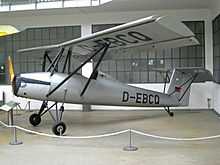Braunschweig LF-1 Zaunkönig
| LF-1 Zaunkönig | |
|---|---|
 | |
| The second Zaunkönig D-EBCQ preserved in the Deutsches Museum, Oberschleissheim, in July 2008 | |
| Role | STOL light aircraft |
| National origin | Germany |
| Manufacturer | Technical University of Brunswick |
| Designer | Dr.-Ing. Hermann Winter |
| First flight | December 1940 |
| Number built | 4 |
The Braunschweig LF-1 Zaunkönig, (LF – Langsames Flugzeug – literally, slow aircraft), is a STOL single-seat light aircraft designed in 1939 by Prof. Ing. Hermann Winter as a fool-proof trainer for novice student pilots to experience solo flight.
Design and construction
The LF-1 was designed by Prof. Dr.-Ing. Hermann Winter and some of his students from the Technische Universität Braunschweig (English:Technical University of Brunswick), Lower Saxony, Germany.[1] Winter was a former chief engineer at the Bulgarian company, DAR (Darzhavna Aeroplanna Rabotilnitsa in cyrillic ДАР – Държавната аеропланна работилница), where he created a line of aircraft; DAR-1, DAR-1A, DAR-2, DAR-3 Garvan, tri motor DAR-4, DAR 5 Brambar, DAR-6 and DAR-7 as well as the DAR Zdravka Vekilski and DAR Zdravka Toprakchiev gliders for the Bulgarian Army.
The LF-1 is a parasol wing monoplane with a high-set tailplane, powered by a Zündapp Z 9-092 engine delivering 37 kW (50 hp), able to operate from a 100 m (330 ft) airstrip. The two-piece wings are set at 16° dihedral and are supported by a pair of v cabane struts and v-struts either side from approx half-span to the lower centre fuselage. Full span leading edge slats extend automatically and full span trailing edge flaps / drooping ailerons can be extended manually by the pilot. The fixed tailwheel undercarriage attaches to the fuselage with long struts and oleo pneumatic shock absorbers.[2]
It was a proof-of-concept design for a 'fool-proof' trainer intended for novice pilots with only one hour of ground instruction, the hour being reduced to five-minutes for those who had already flown gliders, and was intended to be impossible to either stall or spin.[3]
The first prototype, the LF-1 V1, was built in 1940 and made its maiden flight, piloted by Winter himself, in December 1940. Test flights stopped in November 1942 after part of the wing ruptured causing the aircraft to crash. In 1943 a second prototype, the V2, was built, receiving the registration D-YBAR. The aircraft was tested for military applications and was once even armed with a Panzerfaust 100 recoilless anti-tank weapon.
Post-war history

Encouraged by the positive British reviews Prof. Ing. Hermann Winter decided to build a third LF-1. The construction started in 1954 and it was the first new aircraft in Germany after the war to receive a certificate by the Luftfahrt-Bundesamt (LBA) in Braunschweig and the code D-EBAR. Winter envisioned the Zaunkönig as a People's Aircraft affordable for all (for a price of around DM 6,000). On 28 April 1957, the wartime Luftwaffe fighter ace Heinrich Bär was conducting a routine flight check in the D-EBAR. Bär put the aircraft into a flat spin, the final manoeuvre in the test process at Braunschweig-Waggum. The aircraft spun down to 50 m (160 ft) then, unable to regain control, it crashed and Bär received fatal head injuries.[4][5][6] The aircraft was damaged beyond repair and written off.
At the time a fourth LF-1 V4 was already under construction and it flew a few months after the fatal accident with the V3. It received its certificate in 1958 and the code D-ECER. This aircraft flew for some years in Germany until grounded after the death of Prof. Ing. Winter in 1968. It was restored in 1980 and flew until 1999 as D-EBCG and as of 2008 preserved in the collection of the Internationals Luftfahrtmuseum Manfred Pflumm near Villingen-Schwenningen.[7]
Specifications (LF-1)
Data from Die Deutsche Luftruestung 1933–1945 Vol.4 – Flugzeugtypen MIAG-Zeppelin[8]
General characteristics
- Crew: 1
- Length: 6.08 m (19 ft 11 in)
- Wingspan: 8.02 m (26 ft 4 in)
- Height: 2.38 m (7 ft 10 in)
- Wing area: 8.5 m2 (91 sq ft)
- Empty weight: 253 kg (558 lb)
- Gross weight: 370 kg (816 lb)
- Fuel capacity: 40 l (8.80 imp gal; 10.57 US gal) gasoline, 3.5 l (0.77 imp gal; 0.92 US gal) oil
- Powerplant: 1 × Zündapp Z9-092 4-cyl. air-cooled inverted in-line piston engine, 37 kW (50 hp)
- Propellers: 2-bladed wooden fixed pitch propeller, 1.8 m (5 ft 11 in) diameter
Performance
- Maximum speed: 141 km/h (88 mph; 76 kn)
- Cruising speed: 125 km/h (78 mph; 67 kn)
- Landing speed: 46 km/h (29 mph; 25 kn)
- Stall speed: 50 km/h (31 mph; 27 kn)
- Range: 450 km (280 mi; 243 nmi)
- Service ceiling: 3,820 m (12,533 ft)
- Rate of climb: 2.85 m/s (561 ft/min)
- Time to altitude: 1,000 m (3,300 ft) in 6 minutes 42 seconds
1x Panzerfaust 100 mounted above mainplane centre section
See also
References
- Notes
- ↑ 1.0 1.1 Jackson 1973, p. 369
- ↑ Green 1965, p. 79
- ↑ 3.0 3.1 Brown, Eric RN Wings on My Sleeve Orion books, 2006 ISBN 978-0-297-84565-2 p.157-158
- ↑ Kurowski 1996, p. 122.
- ↑ Berger 1999, p. 14.
- ↑
- Frey, Gerhard; Herrmann, Hajo (2004). Helden der Wehrmacht. p. 148.
- ↑ Ogden 2006, p. 201
- ↑ Nowarra, Heinz J. (1993). Die Deutsche Luftruestung 1933–1945 Vol.4 – Flugzeugtypen MIAG-Zeppelin (in german). Koblenz: Bernard & Graefe Verlag. pp. 41–42 & 46–47. ISBN 3-7637-5464-4.
- Bibliography
- Green, William (1965), The Aircraft of the World, Macdonald & Co
- Jackson, A.J. (1973), British Civil Aircraft since 1919 – Volume One, Putnam & Company Limited, ISBN 0-370-10006-9
- Ogden, Bob (2006), Aviation Museums and Collections of Mainland Europe, Air-Britain (Historians) Ltd, ISBN 0-85130-375-7
External links
- TU Brunswick (German)
- (German)
- (French)